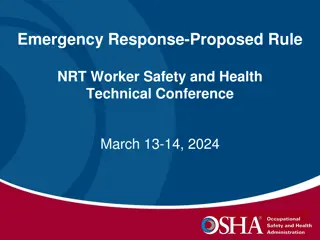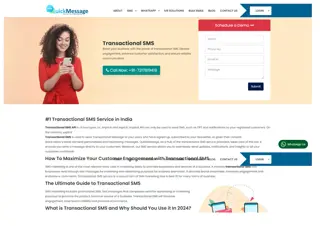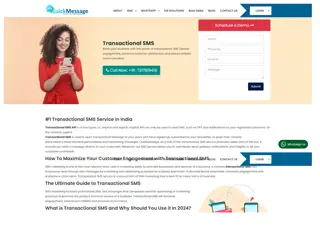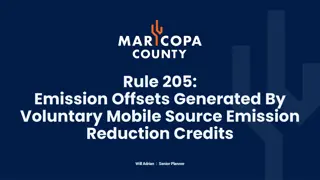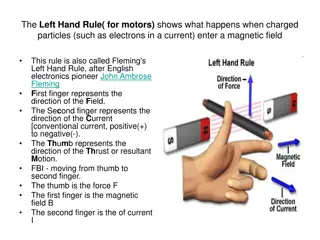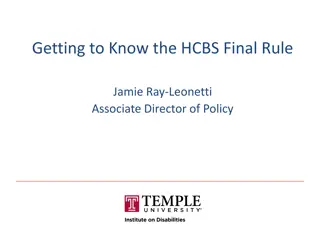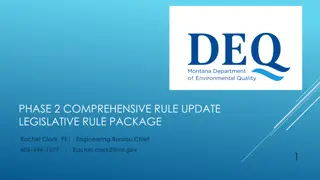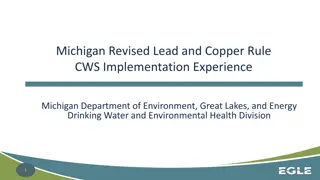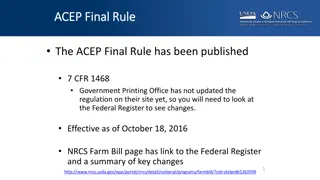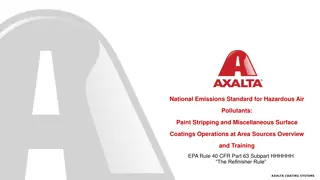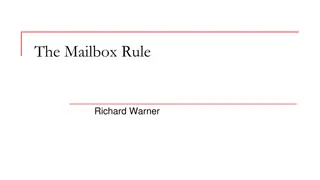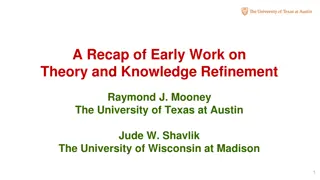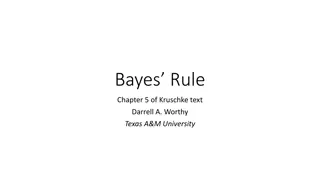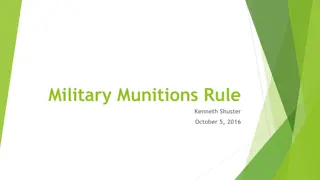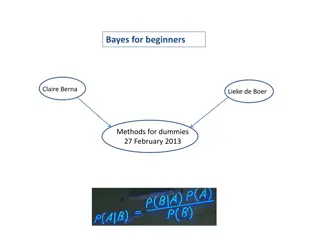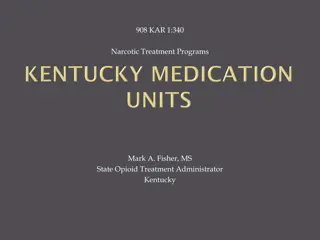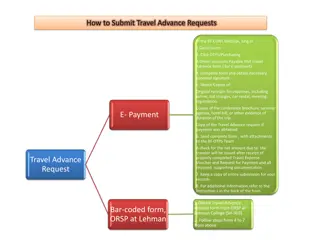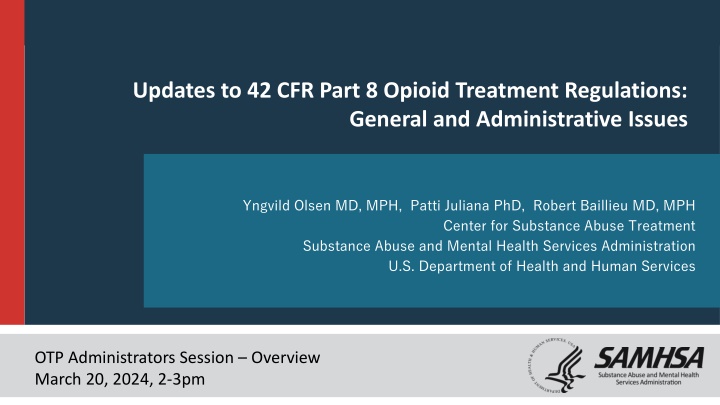
Updates to 42 CFR Part 8 Opioid Treatment Regulations Overview
Explore the latest updates to 42 CFR Part 8 Opioid Treatment Regulations, focusing on patient-centered care, shared decision-making, and fostering trust in a comprehensive environment. Learn about the changes promoting MOUD as a treatment for opioid use disorder and the cultural shifts in care and service delivery.
Download Presentation

Please find below an Image/Link to download the presentation.
The content on the website is provided AS IS for your information and personal use only. It may not be sold, licensed, or shared on other websites without obtaining consent from the author. If you encounter any issues during the download, it is possible that the publisher has removed the file from their server.
You are allowed to download the files provided on this website for personal or commercial use, subject to the condition that they are used lawfully. All files are the property of their respective owners.
The content on the website is provided AS IS for your information and personal use only. It may not be sold, licensed, or shared on other websites without obtaining consent from the author.
E N D
Presentation Transcript
Updates to 42 CFR Part 8 Opioid Treatment Regulations: General and Administrative Issues Yngvild Olsen MD, MPH, Patti Juliana PhD, Robert Baillieu MD, MPH Center for Substance Abuse Treatment Substance Abuse and Mental Health Services Administration U.S. Department of Health and Human Services OTP Administrators Session Overview March 20, 2024, 2-3pm
A Change In How OTPs Deliver Care SAMHSA finalized updates to 42 CFR Part 8, the federal rule that governs Opioid Treatment Programs (OTPs), in February 2024. The effective date of the final rule is April 2, 2024, and the compliance date is October 2, 2024. The revised rule will enhance OTPs, improve collaboration with partner services and facilitate access to medications for opioid use disorder (MOUD). Use this QR Code to link to the SAMHSA webpages on Part 8
Underlying Values and Principles of the Revised Rule Patient-centered care Shared practitioner-patient decision-making Practitioners clinical judgment Responsive, flexible OTP services Evidenced-based practice Non-stigmatizing language 3
These Changes Promote: Acknowledging the skill and patient-centered understanding of treating practitioners Fostering trust and recovery in a patient-centered environment Promoting MOUD as a treatment for a chronic medical condition and reducing stigma Creating responsive, flexible OTP services that are grounded in evidence Cultural Shifts In Care And Service Delivery 4
Fostering trust and recovery in a patient-centered environment The final rule makes permanent flexibilities for the provision of take-homes and revises the criteria for unsupervised take-home methadone doses. o Changes from rule-based to clinical judgment using risk/benefits framework o Allows eligibility for take-home doses upon entry into treatment Removes participation in counseling as a contingency for medication access. Continues to require the OTP to offer adequate treatment services to meet patient needs. 5
Fostering trust and recovery in a patient-centered environment Removes from admissions regulations the one-year OUD requirement for adults and two unsuccessful attempts at withdrawal for patients less than 18 yrs old. Allows patients to begin treatment with MOUD after the screening examination has been completed. Completion of physical and behavioral health assessment within 14 calendar days following admission, and periodically thereafter. Revises the language for drug testing from identifying misuse to a strengths-based approach, such as allowing for extenuating circumstances . 6
Acknowledging the skill and understanding of practitioners s Includes NPs and PAs as practitioners able to order and manage methadone (Medical Director still must be a physician) Potential for medical screening by practitioners external to the OTP. Accepts examination results of non-OTP practitioners, if the exam is verified by an OTP practitioner (e.g. MD, NP, or PA). Total dose for the first day is now up to 50 mgs, unless the practitioner determines that a higher dose was clinically indicated and documents that in the patient s record . 7
Expanding Access to Care Expands access through incorporation of telehealth and integration of care among OTPs: o Initiation of methadone using audiovisual technology o Initiation of buprenorphine through audio-only or audio-visual technology Incorporates harm reduction and recovery principles. o Remove participation in counseling as contingency for medication. o Revises the language for drug testing from identifying misuse to a strengths-based approach, such as allowing for extenuating circumstances . o Allows for distribution of supplies that allow an individual to test their personal drug supply for adulteration with substances that increase the risk of overdose. o Incorporates overdose education and distribution of opioid overdose reversal medications 8
Expanding Access Access expanded by: Expanding the range of services allowed in medication and mobile units Extending use of interim treatment from 120 to 180 days, if comprehensive services are not readily available in the area within 14 days. Requires moving patients from interim to comprehensive treatment during the interim period. Recognizing long-term care facilities and jails with DEA hospital/clinic registrations can dispense methadone when OUD is adjunct to a primary health condition Encouraging collaboration with other services 9
Changes to Certification and Accreditation Content The final rule: Extends the time allotted for corrective action to 180 days (following receipt of the survey report) Distinguishes between minor and significant non-compliance. Introduces a three-year accreditation for OTPs that are required to correct minor non-compliant conditions and One-year accreditation for those required to correct significant non- compliant conditions. Corrections must be made within one year. Adds rules detailing procedures for severe non-compliance. 10
Changes to Certification and Accreditation Content Changes in categories of certification: Transitional certification was removed (extinct) Conditional certification was established (one year certification) OTPs are expected to apply for certification renewal during the final year of the OTP s certification period and before the OTP s certification expires. Extension may be requested by submitting to the Secretary a statement justifying the extension Lapsed programs seeking re-certification will be considered new programs and will be required to apply for provisional certification (one year) 11
Changes to accreditation Clarification of SAMHSA s expectations of ABs: Requires written notice to the OTP and SAMHSA of areas of non- compliance, distinguishing between minor and significant noncompliance. Requires verification of the implementation of the corrective measures by the OTP within the specified schedule. In cases of severe non-compliance that pose immediate risks to patient health and safety, the AB is expected to inform the OTP and Secretary within 48 hours. In case of severe non-compliance, the OTP is given 30 days from the date of the report to correct the issue(s), and the AB is expected to conduct a follow-up survey within 30 days of the expected correction date to ensure successful correction. 12
What does this mean for OTPs Opportunity to: See more patients Improve retention in care Expand the reach of the OTP with mobile units Expand the reach of OTPs with med units in other services Integrate primary care, infectious disease treatments, and mental health services 13
Implementation Activities SAMHSA webpages and documentation have been updated. Revisions to the Federal Guidelines for Opioid Treatment Programs are in process. SAMHSA has scheduled webinars and meetings with implementation partners including: o OTPs (March 20 and 27) o State Officials (March 18) o Accreditation Bodies (March 25 and April 4) SAMHSA will continue to work with its federal partners to facilitate implementation. 14
Thank You! SAMHSA s mission is to lead public health and service delivery efforts that promote mental health, prevent substance misuse, and provide treatments and supports to foster recovery while ensuring equitable access and better outcomes. Grant Opportunities www.samhsa.gov/grants www.grants.gov/web/grants 988 Suicide and Crisis Lifeline Toolkit www.samhsa.gov/find-help/988/partner- toolkit @samhsagov @samhsa_leader /samhsa /samhsa

